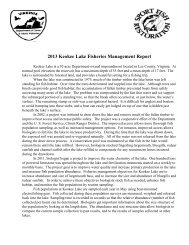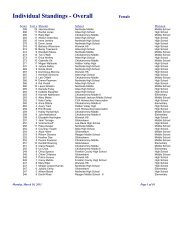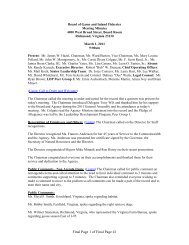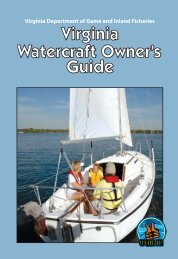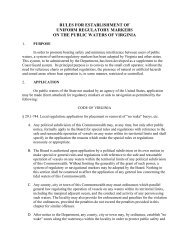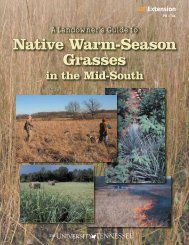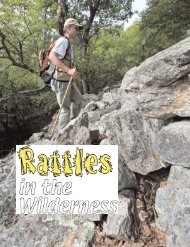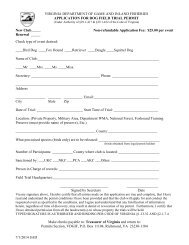2013 Virginia Freshwater Fishing & Watercraft Owner's Guide
2013 Virginia Freshwater Fishing & Watercraft Owner's Guide
2013 Virginia Freshwater Fishing & Watercraft Owner's Guide
You also want an ePaper? Increase the reach of your titles
YUMPU automatically turns print PDFs into web optimized ePapers that Google loves.
<strong>2013</strong> <strong>Fishing</strong> Regs & WOG 11-15-12_Layout 1 11/16/12 1:01 PM Page 35line area), Mattaponi, Pamunkey, Meherrin,and Nottoway.<strong>Fishing</strong> Techniques: Best time from mid-March to early May in fall line areas of tidalrivers as adults return to spawn. Light spincastingrods and reels, with 1/32 to 1/8 oz.,brightly colored shad darts, spoons, jigs, orsmall minnow imitation lures. Fly fishingwith darts, gold or white soft-bodiedstreamers, and other wet flies. Increasedsuccess in deeper water; do not usuallyjump but give a good fight; need to be carefullyplayed to avoid tearing delicate mouth.Check current regulations for restrictions.Hickory ShadCommon Names: Hickory, silver shad.Identification: River herring family, averagingaround 1 lb., with fish up to 2 lbs. common.Silver-sided with grayish-green backand a prominent dark spot, followed by arow of lighter spots (especially when fresh)on the upper part of the side just behind thegill cover; body long but compressed, asymmetricaltop to bottom and in cross section itis wedge-shaped; the lower jaw protrudessignificantly beyond the upper jaw when themouth is closed. Each scale on the sides hasa small dark spot.Best <strong>Fishing</strong>: Rivers: Rappahannock (fall linearea in Fredericksburg), James (Richmondfall line area), Appomattox, Chickahominy(below Walker’s Dam), Mattaponi,Pamunkey, and Nottoway.<strong>Fishing</strong> Techniques: Mid-March into Maywith spring spawning run, arriving earlierthan American shad. Light spin casting usingvery small, brightly colored shad darts,spoons, jigs, or minnow imitation lures. Flyfishing with darts, gold or white streamers,and other wet flies. Often taken near the surface,will “tail-walk” and sometimes jump.Check current regulations for restrictions.Longnose GarCommon Names: Billy gar, billfish, garfish,garpike.Identification: Living relic of prehistoricpast; family dates back 245 million years.Nothing in <strong>Virginia</strong> is even remotely similarto the gar. The long narrow beak-like jaw,laden with sharp teeth, is the unmistakablefeature. Very long, cylindrical fish withdorsal and anal fins set well back on thebody, and a large rounded tail fin; note thearmament of very large, hard, sharp, bonyscales. Brownish-olive on its back, fading toyellowish- or olive-green to white on itsbelly; 2 to 3 ft in length is not uncommon.Best <strong>Fishing</strong>: Lakes: Western Branch, Prince,Chickahominy and Buggs Island. Rivers:Chickahominy, Pamunkey, James andRappahannock.<strong>Fishing</strong> Techniques: Large minnows are beston medium to heavy casting and spinningtackle. They are adept at stripping bait fromhooks and difficult to hook in their bony jaw.Feed at night, especially moonlit nights.AlewifeBlueback HerringBlueback Herring & AlewifeCommon Names: River herring.Identification: Blueback herring and alewifeare almost identical looking; the best way totell them apart is an internal difference,blueback have a black membrane that linesthe abdominal cavity and alewife have a lightcolored one with few, scattered spots. Bluebackare bluish along the back with a silveryhead; alewife is grayish-blue above, with abronze head. Maximum length is 12 to 15inches and less than 1 lb.<strong>Fishing</strong>: Because stocks are depressed thereis no harvest permitted in the waters flowinginto North Carolina (Meherrin, Nottoway,Fish illustrations by Duane Raver/USFWSBlackwater, North Landing and Northwestrivers and their tributaries plus Back Bay).The <strong>Virginia</strong> Marine Resources Commissionhas enacted a ban on the possessionof river herring, effective January 1, 2012,due to the collapse of the stock over the past40 years and in order to comply with anAtlantic States Marine Fisheries Commissionfishery management plan directive.BowfinCommon Names: Grindle, grinnel.Identification: Bowfin are living relics, withprimitive roots back 70 million years ago.Has a long, soft-rayed dorsal which arches ina bow over most of the length of its body.Tail is rounded, with distinct black spotrimmed with orange on males; black spot onfemales faint or absent and no orange rim.Its back and sides are brownish-green orolive-green, with mottled sides fading toyellowish or white. During spawning, itsunderside turns a bright yellow-green. Has acylindrical body and a wide flattened head,almost snake-like, with deep-set dark eyes.Snout is rounded with short nasal barbels.Mouth is large and has conical-shaped teeth.Note: While the bowfin shares similarcoloration and body shape with the northernsnakehead (recently introduced to thePotomac River), the anal fin of a bowfin ismuch shorter than that of the snakehead,and snakeheads will not have the spot foundon bowfin.Best <strong>Fishing</strong>: Lakes: Chickahominy, LittleCreek and Diascund. Rivers: Chickahominy,Mattaponi, Pamunkey, Nottoway andBlackwater.<strong>Fishing</strong> Techniques: They are strong, muscularfighters and strike at all manner of livebait and many artificials. Often fools anangler into thinking it’s whipped, and thensuddenly explodes back to life. Minnows anda variety of jigs are best baits. Spinner baitsand bass jigs work well for summertimebowfin; in winter, vertical jigging spoons andblade baits can be effective. Use a good stiffrod with at least 15-lb test line. Steel leadersmay be necessary and don’t try to lip holdthese fish! Food value is generallyconsidered poor.www.HuntFishVA.com 35



